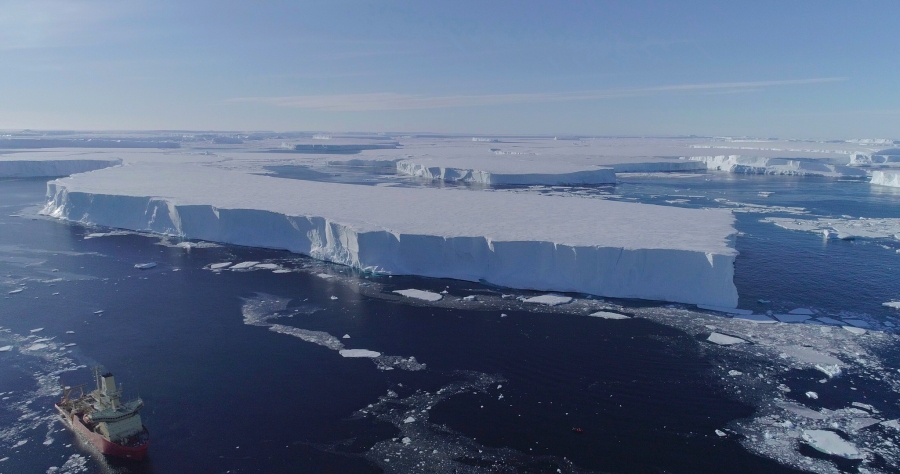TAMPA, Fla. (WFLA) — Thwaites Glacier, also known as the Doomsday Glacier, in Antarctica is among the most vulnerable and concerning glaciers on the planet. That’s because it’s huge — the size of Florida — and global warming is making the ice unstable, threatening to accelerate sea level rise.
Thwaites has been in the news a lot over the past week. That’s because a scientist by the name of Alastair Graham, from right here in the Tampa Bay area at the University of South Florida, just published a groundbreaking and alarming study. Alastair Graham visits Thwaites Glacier during a recent exploration It may seem ironic that Graham studies the massive glacier here in the tropics at USF’s downtown St.
Petersburg campus, 7,000 miles away from Antarctica. But as an expert in marine geophysics he knows that when it comes to melting ice, the impact will be felt all around the world and especially in low-lying coastal zones like Florida. WFLA’s Chief Meteorologist and Climate Specialist Jeff Berardelli met with Graham at USF to discuss his findings.
“You can look around the world at Antarctica, but also Greenland, Iceland, mountain glaciers in Europe – we are seeing things going in the wrong direction,” Graham warns. “The chances right now look like Thwaites is gonna impact and rewrite some of the coastline shape for our state. ” Thwaites holds enough ice, that if melted, would raise sea levels 2 feet.
But it Thwaites collapsed it would also destabilize it’s neighbor glaciers, eventually adding up to several feet of sea level rise. Thwaites Glacier/ Alastair Graham Now graham’s new study is escalating concerns of a more rapid retreat, “What our study has done is looked at the past history of Thwaites, what’s been going on in the past couple of hundred years. ” To do that, Graham’s team had to examine the ocean bottom where the glacier used to rest, a technological feat that’s only become possible in the past few years.
To look backwards in time, the team used sonar from an autonomous submarine to map the nooks and crannies of the sea floor 1000 feet below. Sea Floor Map in front of Thwaites / Graham Et Al 2022 Berardelli: “These are the ridges that essentially catch the ice shelf so it retreats more slowly?” Graham: “That’s right, anything that pops up and is higher up tends to be a place where ice can at least hold on. ” But lately – as the glacier thins – it’s getting harder for the ice to hold on.
Graham’s marine map reveals a recent history of not so glacial movement, “The historical footprint of Thwaites suggests that something more dramatic happened not that long ago,” explains Graham. Graham’s research found that for a short period within the last 200 years, Thwaites receded twice as fast as it is now, revealing that rapid retreat is not only possible but probable, in the near future. “We are saying that maybe in the next 5 to 10 years it’s highly likely for it to lose contact with that seabed ridge,” Graham warns.
Thwaites view from the sky/ Alastair Graham Thwaites glacier is anchored to the bedrock on what’s called a grounding line, where it is pinned to a ridge. That ridge acts as a barrier, slowing the flow of ice sliding into the ocean. But its grip is fragile.
Thwaites Glacier Visualization created by WFLA Recently warm water currents have been undercutting thwaites floating ice shelf, destabilizing the underbelly. The fear is – with continued warming – the glacier retreat from the grounding line will accelerate, with more of that once grounded ice floating into the ocean, raising the sea level Graham says the amount of ice loss is staggering, “Thwaites right now is losing 50 billion tons of ice per year, that’s a net loss, and the concern for the future is that is going to increase. ” To put that into perspective, this animation shows what one billion tons of melted water looks like.
NASA visual of one billion tons (gigatons) of ice melt on top of Central Park, NYC Now multiply that by 50. That’s how much water Thwaites is adding to our oceans each year. And that’s only one of many melting glaciers.
Still, Graham emphasizes that there’s no need to pani. In geological terms, rapid retreat, or even collapse, is not an overnight process. “We talk about the Doomsday Glacier which I don’t think is particularly useful because it suggests that you have this annihilation.
I think that’s a mistake,” explains Graham. “Thwaites has the potential to become a doomsday glacier but it’s a very slow process and I think over the next 20-30 years we might see a lot of change at Thwaites and increases in sea level rise from Thwaites that will start affecting our coastlines, particularly here in Florida where everything is low lying. ” Here’s the take away: Glaciers all around the Earth are melting at an accelerating rate.
The sea level will rise and coasts will be swamped over time – there’s no getting around it. It’s already baked into the system because of the excess heat humans have already added to the oceans. But its not too late to control the pace to make sure there’s plenty of time for us to adapt to rising seas.
.
From: wfla
URL: https://www.wfla.com/weather/climate-classroom/antarctic-glacier-may-soon-rapidly-retreat-usf-study-finds/



